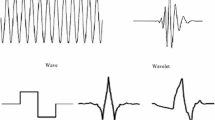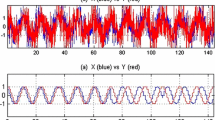Abstract
Using wavelet methods, this paper analyzes the relationship between the age-adjusted, infant, and cause-specific mortality rates and the business cycle in Sweden over the period 1800–2000 (1911–1996 for cause-specific mortality). For the period 1800–2000, an increase in GDP by 1% decreased mortality by 0.7%. This overall relationship is due to a strong counter-cyclical relationship in the nineteenth century, which disappeared in the twentieth century. In contrast, in the twentieth century higher mortality in economic upturns is found for mortality caused by circulatory diseases (including stroke) and accidents.









Similar content being viewed by others
Notes
Compared to this paper, different types of harvest indices were used, rather than GDP, as business cycle indicators.
One Fourier transform is \({\rm F}(\varpi )=\int_{-\infty }^\infty {\rm f(t)e} ^{-{\rm i}\omega {\rm x}}dt,\) which builds on the Euler identity eiy = cos(y) + i·sin(y), with i being the imaginary unit.
1 US Dollar = 7.96 Swedish Krona, October 29, 2008.
The coefficients generated by MODWT are affected by the boundary condition at the beginning and the end. If the filter is of length L where (2j − 1) (L − 1) coefficients are affected for scale j, whereas (2j − 1) (L − 1)-1 beginning and (2j − 1) (L − 1) ending details and smooth coefficients are affected (Percival and Walden 2000). The Haar-Wavelet (L = 2) has the shortest possible filter length.
The Hodrick-Prescott filter is often used in macroeconomic papers to extract business cycle dynamics. The Hodrick-Prescott filter, besides serious methodological drawbacks, such as the creation of spurious cycles, does not allow for the analysis of different independent time scales, which, as we show here, might provide deeper insights into what explains the relationship between mortality and GDP.
A difference in this paper compared to Granados and Ionides (2008) is also that we use a newer historical GDP data, which is extrapolated backwards from modern official data in accordance with standards of national accounting. This implies that the data used in this paper fits much closer to official statistics for the twentieth century compared to the data in Granados and Ionides (2008), who use historical data on production and extrapolate this forward in time to the present.
References
Biddle JE, Hamermesh DS (1990) Sleep and the allocation of time. J Polit Econ 98(5):922–943
Black PH, Garbutt LD (2002) Stress, inflammation and cardiovascular disease. J Psychosom Res 52(1):1–23
Brenner HM (1971) Economic changes and heart disease mortality. Am J Public Health 61(3):606–611
Brenner HM (1979) Mortality and the national economy. A review, and the experience of England and Wales, 1936–76. Lancet 15(2):568–573
Brenner HM, Mooney A (1983) Unemployment and health in the context of economic change. Soc Sci Med 17(16):1125–1138
Chou S-Y, Grossman M, Saffer H (2004) An economic analysis of adult obesity: results from the Behavioral Risk Factor Surveillance System. J Health Econ 23(3):565–587
Cutler DM, Landrum MB, Stewart KA (2008) Intensive medical care and cardiovascular disease disability reductions. In: Cutler DM, Wise DA (eds) Health at older ages: the causes and consequences of declining disability among the elderly. University of Chicago Press, Chicago, pp 191–222
Daubechies I (1992) Ten lectures on wavelets. In: CBSM-NSF regional conference series in applied mathematics, SIAM, Philadelphia
Dee T (2001) Alcohol abuse and economic conditions: evidence from repeated cross-sections of individual-level data. Health Econ 10(3):257–270
Drevenstedt GL, Crimmins EM, Vasunilashorn S, Finch CE (2008) The rise and fall of excess male infant mortality. Proc Natl Acad Sci USA 105:5016–5021
Edvinson R (2005) Growth, accumulation, crisis: with new macroeconomic data for Sweden 1800–2000. Almqvist & Wiksell International, Stockholm
Elisaf M (2001) The treatment of coronary heart disease: an update—part 1: an overview of the risk factors for cardiovascular disease. Curr Med Res Opin 17(1):18–26
Fenwick R, Tausig M (1994) The macroeconomic context of job stress. J Health Soc Behav 35(3):266–282
Gallegati M, Gallegati M (2007) Wavelet variance analysis of output in G-7 countries. Stud Nonlinear Dyn Econom 11(3), Article 6
Gencay R, Selcuk F (2001) An introduction to wavelets and other filtering methods in finance and economics. Academic Press, Salt Lake City
Gencay R, Selcuk F, Whitcher B (2005) Multiscale systematic risk. J Int Money Financ 24(1):50–70
Gerdtham UG, Johannesson M (2005) Business cycles and mortality: results from Swedish microdata. Soc Sci Med 60(1):205–218
Gerdtham UG, Ruhm CJ (2006) Deaths rise in good economic times: evidence from the OECD. Economics & Human Biology 4(3):298–316
Granados JAT (2005) Increasing mortality during the expansions of the US economy, 1900–1996. Int J Epidemiol 34(6):1194–1202
Granados J, Ionides E (2008) The reversal of the relation between economic growth and health progress: Sweden in the 19th and 20th centuries. J Health Econ 24(3):544–563
Gravelle HS, Hutchinson G, Stern J (1981) Mortality and unemployment: a critique of Brenner’s time-series analysis. Lancet 2(8248):675–679
Johansson Ö (1967) The gross domestic product of Sweden and its composition 1861–1955. Almqvist & Wiksell, Stockholm
Krantz DS, McCeney MK (2002) Effects of psychological and social factors on organic disease: a critical assessment of research on coronary heart disease. Annu Rev Psychol 53(1):341–369
Lau KM, Weng H (1995) Climatic signal detection using wavelet transform: how to make a time series sing. Bull Am Meteorol Soc 76(12):2391–2402
Lindahl O (1956) The gross domestic product of Sweden 1861–1951. Konjunkturinstitutet, Stockholm
Lindahl E, Dahlgren E, Kock K (1937) National income of Sweden 1861–1930, part one and two. PS King & Son and Nordstedt, Söner, Stockholm
Mallat S (1998) A wavelet tour of signal processing. Academic Press, San Diego
Neumayer E (2004) Recessions lower (some) mortality rates: evidence from Germany. Soc Sci Med 58(6):1037–1047
Novo M, Hammarström A, Janlert U (2001) Do high levels of unemployment influence the health of those who are not unemployed? A gendered comparison of young men and women during boom and recession. Soc Sci Med 53(3):293–303
Ogburn WE, Thomas DS (1922) The influence of the business cycle on certain social conditions. J Am Stat Assoc 18(139):324–340
Percival PD, Walden TA (2000) Wavelet methods for time series analysis. Cambridge University Press, Cambridge
Pickering T, Clemow L, Davidson K, Gerin W (2003) Behavioral cardiology—has its time finally arrived? Mt Sinai J Med 70(2):101–112
Ruhm CJ (2000) Are recessions good for your health? Q J Econ 115(2):617–650
Ruhm CJ (2005) Healthy living in hard times. J Health Econ 24(2):341–363
Ruhm CJ, Black WE (2002) Does drinking really decrease in bad times? J Health Econ 21(4):659–678
SCB (1911–1996) Sveriges Officiella Statistik: Dödsorsaker
SCB (2006) SCB statistikdatabaser: Arbetsmarknad, Befolkning, Utbildning och forskning
Sparks K, Cooper C, Fried Y, Shirom A (1997) The effects of hours of work on health: a meta-analytic review. J Occup Organ Psychol 70(4):391–408
Svensson M (2010) Economic upturns are good for your heart but watch out for accidents: a study on Swedish regional data 1976–2005. Appl Econ 42(5):615–625
Thomas DS (1925) Social aspects of the business cycle. Routledge, London
Thomas DS (1941) Social and economic aspects of Swedish population movements 1750–1933. The Macmillan Company, New York
Wagstaff A (1985) Time series analysis of the relationship between unemployment and mortality: a survey of econometric critiques and replications of Brenner’s studies. Soc Sci Med 21(9):985–996
Acknowledgements
We thank two anonymous referees, Lars Hultkrantz, and seminar participants at Örebro University for helpful comments and suggestions.
Author information
Authors and Affiliations
Corresponding author
Additional information
Responsible editor: Junsen Zhang
Rights and permissions
About this article
Cite this article
Svensson, M., Krüger, N.A. Mortality and economic fluctuations. J Popul Econ 25, 1215–1235 (2012). https://doi.org/10.1007/s00148-010-0342-8
Received:
Accepted:
Published:
Issue Date:
DOI: https://doi.org/10.1007/s00148-010-0342-8




